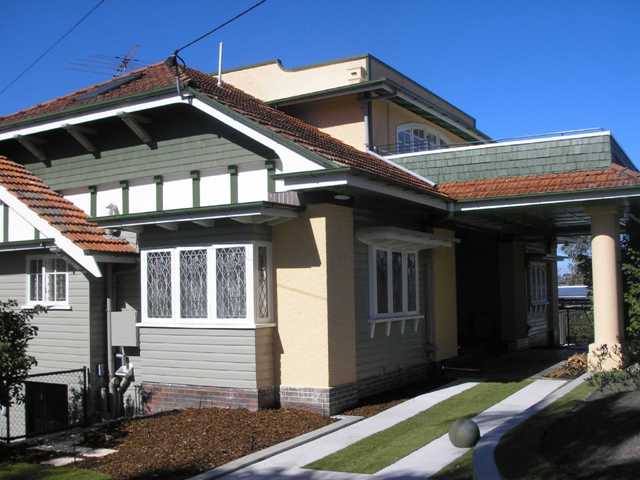Addresses
Type of place
House
Period
Interwar 1919-1939
Style
California Bungalow
Addresses
Type of place
House
Period
Interwar 1919-1939
Style
California Bungalow
This house was built for Wallace Bishop, a prominent Brisbane jeweller, and was designed in the distinctive American Bungalow style by architect Charles Griffin in 1927. The name, 'Au-Argentum', means 'gold and silver', in Latin. The California Bungalow style was a distinctive feature of interwar architecture.
Lot plan
L6_RP808625
Key dates
Local Heritage Place Since —
Date of Citation —
Construction
Roof: Tile;Walls: Timber
People/associations
Charles Herbert Griffin (Architect);Wallace Bishop (Occupant)
Criterion for listing
(E) Aesthetic; (H) Historical associationInteractive mapping
Lot plan
L6_RP808625
Key dates
Local Heritage Place Since —
Date of Citation —
Construction
Roof: Tile;Walls: Timber
People/associations
Charles Herbert Griffin (Architect);Wallace Bishop (Occupant)
Criterion for listing
(E) Aesthetic; (H) Historical associationInteractive mapping
History
The house was featured in the 8 September edition of the Brisbane Courier, fie years after construction, billed as "Garden and Bush Beyond – A Brisbane House Suggestive of the Outdoors".
This house was designed in the distinctive American Bungalow style by architect Charles Griffin in 1927. C. (Chas.) Griffin was a London-trained architect who practised in Brisbane from 1919. His known houses were in the Bungalow style with classical decorative touches.
Description
The roof of this house is terra-cotta tiles on visible, pitched surfaces and low pitched metal roofs behind parapets or on window hoods. Its walls are based on brick and above floor level are either weatherboards or stucco. To the front, wall panels of weatherboards are positioned between stucco pilasters in a minimalist classical ordering. Panels of shingles or battened fibro sheeting are also used decoratively in gables, or parapets, or balustrades, and lattice panels are used below floor level. The house is symmetrical from the street, centred on an over scaled porte-cochere with paired plain columns on the leading corners, leading to the relatively tiny front double doors with semi-circular fanlight over. This juxtaposition of scale is eye-catching. The windows are diamond patterned leadlight casements, grouped into banks or bays. The high-level window above the entrance has an arched top and compliments the entry fanlight below. Much of the decoration of the house is intrinsic to the structure and construction techniques of the house, as is the nature of the Californian Bungalow style.
The house is prominent in the streetscape with only a low-height formal garden in its front yard.
The house backs onto a grass tennis court with a terra-cotta roofed pavilion on its far side. There is a later pool to the McCaul Street side of the house. A mature pine tree is placed between the pool and Darvall Street.
Statement of significance
Relevant assessment criteria
This is a place of local heritage significance and meets one or more of the local heritage criteria under the Heritage planning scheme policy of the Brisbane City Plan 2014. It is significant because:
References
-
Rod Fisher and Brian Crozier (editors), The Queensland House, Queensland Museum Publication, 1994
-
The Brisbane Courier, September 8 1932, p 5
Citation prepared by — Brisbane City Council (page revised September 2020)

